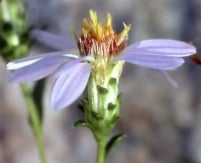Department of Biology
ESC 350
200 University Ave. W
Waterloo, Ontario, Canada N2L 3G1
Phone: (519) 888-4567 ext. 32569
Fax: (519) 746-0614
Eurybian Asters
 Eurybia Nees is an predominantly eastern North American x=9 genus of 22 species of white and blue-purple rayed asters with flat-topped arrangement of heads (except in some species of subg. Heleastrum), phyllaries usually with thumbnail-shaped dark chlorophyllous zone and large marginal hairs. Some species of subg. Eurybia are native to western North America. The pappus of the fruit is quadruple with shorter 2° outer and inner whorls and longer 1° non clavate outer and clavate inner whorls (Semple and Hood 2005).
Eurybia Nees is an predominantly eastern North American x=9 genus of 22 species of white and blue-purple rayed asters with flat-topped arrangement of heads (except in some species of subg. Heleastrum), phyllaries usually with thumbnail-shaped dark chlorophyllous zone and large marginal hairs. Some species of subg. Eurybia are native to western North America. The pappus of the fruit is quadruple with shorter 2° outer and inner whorls and longer 1° non clavate outer and clavate inner whorls (Semple and Hood 2005).
 Eurybia includes two subgenera and nine sections following Nesom's 1994 treatment. Xiang and Semple (1996) found that species representing the two subgenera were closely related in a clade that included a cultivar of Aster amellus, which is enigmatic since the two genera are not closely related within the tribe. Sericocarpus was found to be the sister group to the Eurybia clade by Xiang and Semple (1996; treated as Aster), but this is likely an artifact of the data set. Brouillet, Allen, Semple and Ito (2001) found some support for Nesom's treatment, although additional work was needed to resolve the relationships of the several species groups that formed a polytomy at the base of the Eurybia-Machaerantherinae clade. The Herrickia group formed one of these polytomies, but other groupings proposed by Nesom and listed below were not supported. Brouillet, L., L. Urbatsch & R.P. Roberts (2004) presented DNA sequence data supporting recognition of Oreostemma, Herrickia, Eurybia and Triniteurybia (a new monotypic genus) the formed a grade at the base into the Machaerantherinae. Selliah and Brouillet (2008) used ITS and ETS sequence data to study the phylogeny of diploid species of Eurybia and concluded that their results did not support any of the infrageneric classifications of Eurybia. Results for polyploids were inconsistent. Three morphologically and ecologically distinct species grouped together in a clade in the Selliah & Brouillet study: E. integrifolia, E. sibirica, and E. eryngiifolia. In his treatment of the genus for Fl. N. America, Brouillet (2006 FNA) groups morphologically similar species. Further work is needed to resolve the infrageneric classification and species relationships within Eurybia.
Eurybia includes two subgenera and nine sections following Nesom's 1994 treatment. Xiang and Semple (1996) found that species representing the two subgenera were closely related in a clade that included a cultivar of Aster amellus, which is enigmatic since the two genera are not closely related within the tribe. Sericocarpus was found to be the sister group to the Eurybia clade by Xiang and Semple (1996; treated as Aster), but this is likely an artifact of the data set. Brouillet, Allen, Semple and Ito (2001) found some support for Nesom's treatment, although additional work was needed to resolve the relationships of the several species groups that formed a polytomy at the base of the Eurybia-Machaerantherinae clade. The Herrickia group formed one of these polytomies, but other groupings proposed by Nesom and listed below were not supported. Brouillet, L., L. Urbatsch & R.P. Roberts (2004) presented DNA sequence data supporting recognition of Oreostemma, Herrickia, Eurybia and Triniteurybia (a new monotypic genus) the formed a grade at the base into the Machaerantherinae. Selliah and Brouillet (2008) used ITS and ETS sequence data to study the phylogeny of diploid species of Eurybia and concluded that their results did not support any of the infrageneric classifications of Eurybia. Results for polyploids were inconsistent. Three morphologically and ecologically distinct species grouped together in a clade in the Selliah & Brouillet study: E. integrifolia, E. sibirica, and E. eryngiifolia. In his treatment of the genus for Fl. N. America, Brouillet (2006 FNA) groups morphologically similar species. Further work is needed to resolve the infrageneric classification and species relationships within Eurybia.
Summary of infrageneric classification
All species of Eurybia (a monophyletic genus) have been treated as members of Aster in North American floras. The nomenclature below is a significant shift in what had been standard, but it is supported on the basis of morphology, but not molecular studies. Members of sect. Eurybia (Biotia) have heart-shaped basal leaves, while those of other sections have oblanceolate or obovate basal leaves. Nesom divided subg. Eurybia into five sections, while I have lumped sect. Radulini into sect. Calliastrum here. Continued used of this subgeneric classification is done for convenience in grouping morphologically similar species, but will likely have to be abandoned when a more complete molecular phylogeny of the genus is developed.
Eurybia subg. Eurybia
-
Eurybia sect. Eurybia (Biotia)
- Eurybia ×herveyi (E. macrophylla × E. spectabilis)
-
Eurybia sect. Callisastrum
- Western North American
- Eastern North American
- Eurybia sect. Integrifolia
Eurybia subg. Heleastrum
-
Eurybia sect. Heleastrum
-
Eurybia sect. Eryngiifolii
Brouillet, L. 2006. Eurybia (Cassini) Cassini in F. Cuvier. pp. 365--382. In Flora North America Editorial Committee, eds. Flora of North America. Vol. 20. Asteraceae, Part 2. Astereae and Senecioneae. Oxford University Press, New York.
Selliah, S. & Brouillet, L. 2008. Molecular phylogeny of the North American eurybioid asters, Oreostemma, Herrickia, Eurybia, and Triniteurybia (Asteraceae, Astereae) based on the
ITS and 3’ETS nuclear ribosomal regions. Botany 86: 901-915.
Last updated 15 February 2014 by J.C. Semple
© 2014 J.C. Semple, including all photographs unless otherwise indicated




